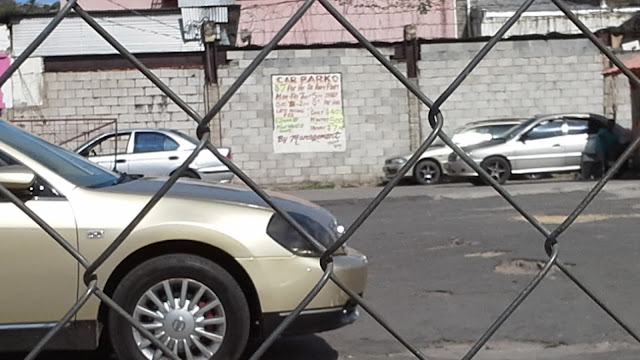Lady making her way down town from bus terminal Many Afro-Trinidadians utilise the public transport services.
Different Face Different Places
As mentioned before in our “To buy a car or not buy a car? That
is the question” blog diversity on public transportation in Trinidad is
limited. This is due to the fact the racial divide that occurs in Trinidad.
Afro-Trinidadians tend to work lower wage earning jobs while Indo-Trinidadian
tend to work more professional jobs. This leads to more Afro-Trinidadians being
unable to afford to purchase their own car. Additionally, the smaller white
population of Trinidad tend to be business wealthy business owners who would
not be caught dead on a maxi travelling to Port of Spain.
In essence, Afro-Trinidadians make up the majority of the
faces you see on the maxies in Trinidad. Adrica Simmion, a regular maxi traveller,
confessed that main “black” people take maxi. She stated that Indo-Trinidadians
usually have their own cars that they drive.
However, the buses are a much different case. The Public
Transports Service Cooperation (PTSC) busses run straight from the eastern side
of the island down to the southern side of the island. The southern areas of
Trinidad are known to have a predominately Indo-Trinidadian population. Hence, it
is not uncommon to see many Indo-Trinidadians on the PTSC buses flocking
downing South on the weekends. This is especially true for university students
who live down south but study at the University of the West Indies, St
Augustine campus in the northern section of the island.
According to one such student of Analice Ramkisson, who
lives in a small settle just outside Princetown, travelling home by bus on
weekends feels like a huge reward for the long she has had. According to
Analice life down south is much nicer. It’s where most of her family and
friends so she does not mind the long bus ride. Analice agreed she’d love to
have her parents come pick her up in the family car but that is not always possible
as both of them work so she makes the sacrifice and takes the bus home. She
continued to say that she could stay up if they can not come for her but she
would much rather the slight inconvenience of the bus to get home than staying
up on the northern side of island. Analice additionally confessed that she never
takes a maxi to go anywhere, as she never goes to Port of Spain and her parents
always drop her into Princetown if she needs to go.
According to Glaeser et
al. (2006), more than 19 percent of people in cities are poor vs only 7.5
percent of persons in suburbs. This corresponds with Analice’s statement that
she has no need to take public transport besides to “down south” on the
weekends. Another student, also of Indo-Trinidadian decent, Vinash Ramdass,
states that he has no need to take maxi or bus as he has a car given to him by his
parents. He admits he never goes into Port of Spain as he has need to. He confessed
that his mother does all of his shopping “down south”.
The mere fact that finding statistics to validate the
observations made shows an even deeper underlying problem. For such an ethnically
diverse country like Trinidad one would expect there to be many studies done on
the economic disparities between the various races.
According to Ashlee, an Afro-Trinidadian UWI student from Arima,
travelling to and from school, Port of Spain and anywhere else via maxi is her
fate which she endures because she is not fortunate enough to be able to afford
a car. As stated in our “To buy a car or not buy a car? That is the question”
cars are an expensive asset. According to Ashlee, catching maxi is common
people of her “type”, meaning people of her race. She further states that she
often takes trips to Port of Spain with her mother and sometimes friends, to
shop.
According to Seiler (2007) historically “black” persons were
not allowed to take public transport. If they did they were subjected to police
harassment and bigotry. Seiler (2007) states that only “elite blacks” such
athletes and entertainers were permitted on public transport. Surely things have
come a long way. Now “blacks” dominate the public transport railways while
other races avoid them.
Steven Williams, a Caucasian Trinidadian, who is an
executive manager on board of companies, confess that he hates taking any form
of public transport and rarely ever ventures into the city, unless on business.
He says he’d rather drive himself and pay the high cost of parking in one of
the many car parks in the city as mentioned in our “The
Economics of Parking in Port of Spain”. He added that he has not
taken a maxi since his very early school days. Not to make the other races left
out, Jenna, of Spanish Venezuelan descent and Chang of Asian descent, when
speaking to us admitted that they have never taken a maxi in their lives as
there families have always been fortunate enough to have had cars. It was then
discovered that Jenna’s parents are store owners and Chang’s parents own numerous
Chinese restaurants. They further disclosed that they too rarely ever venture
into Port of Spain, but do most of their shopping at the mall where there is better
parking.
Clearly, there is a limited diversity on the public
railways. This lack of diversity seems mainly driven by economic disparities in
the country. I wonder if anyone else noticed.





